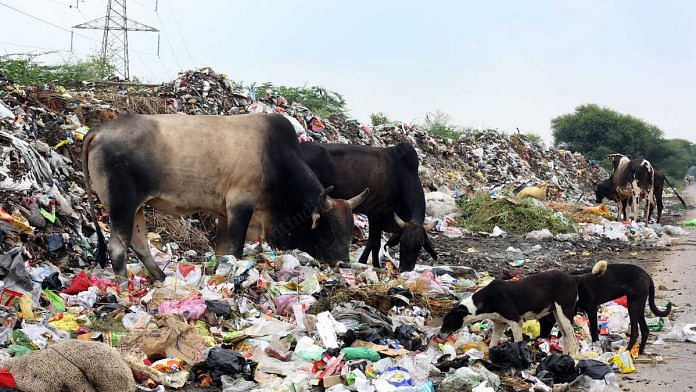Thank you dear subscribers, we are overwhelmed with your response.
Your Turn is a unique section from ThePrint featuring points of view from its subscribers. If you are a subscriber, have a point of view, please send it to us. If not, do subscribe here: https://theprint.in/subscribe/
Three Facts:
1)This article is based on Vatavaran’s solid waste management work selected among the global 100 Best Practices by the United Nations Cell for Human Habitation.
2)While biodegradables produce disease-causing germs if not treated for 8-10 hours in hot & humid weather conditions; the breeding grounds of their hosts invariably get created by plastics choking sewage pipes and rain water harvesting channels.
3)Rich enchants, entice & entrap poor into unethical, unhealthy and unnatural lives.
Impacts
Garbage dumps are eyesores in human habitation areas and at landfill sites they produce killing methane. They pollute our soil, air & water and are breeding grounds for germs of infectious diseases like plague, tuberculosis, dysentery, diarrhoea, eye infections and skin ailments.
The poor living around landfills and rag pickers rummaging through un-segregated heaps of garbage are most vulnerable to these diseases. According to the World Health Organization, every year 50-lakh people die due to diseases related to improper disposal of waste.
Rich man and poor man’s garbage
The household garbage of a rich man would have vegetable peels, rotting and/or half-eaten vegetarian and/or non-vegetarian meals & fruits, pieces of paper, plastic bags, cracked pieces of crockery, empty bottles, discarded cosmetics, batteries, e-waste, hair sprays, insect repellents, detergents, antacids, paints, stain removers etc. Many contain chemicals like Aluminum, Ammonia, Lead, Methylene chloride, Formaldehyde, Mercury, CFC (Chloro Fluro Carbons) etc.
A poor man’s garbage has peels, plastic bags, disposable paper products, sachets and pouches of tea, coffee, toffees, spices, Sindhoor etc.
The disparity in garbage generation by the rich and poor is astounding. On an average, a rich person generates up to 3 kilograms of garbage every day whereas a poor person generates .3 % of that. A rich man’s garbage is about 40% biodegradable, 55 % recyclable and 5 % unidentified wastes. As compared to poor man’s garbage which is 96% biodegradable, 3% recyclables and 1 % unidentified wastes.
Then why are poor colonies dirtier?
The rich produce 300 times more garbage than the poor but the poor localities are dirtier. Seven reasons for that are:
-
- Dependence on mini sachets and pouches for one time use products.
- The area of each shanty being too small to accommodate a garbage receptacle.
- Absence of appropriately designed garbage bins for small but overcrowded spaces.
- Inadequate number of community garbage bins and their inappropriate placement.
- Inefficiency of government staff in emptying out the community bins and keeping them clean.
- Poverty stricken householders unable to hire private work force to manage garbage.
- Householders either earn from recyclables or from cleaning rich people’s garbage developing apathy to their own garbage.
Result is householders discarding sachets anywhere and rest in drains running in front of the households blocking them and letting wastewater stagnate in garbage strewn pathways.
Four models of garbage management -based on the income of house holders:
-
- More than 50% slum and low-income colony dwellers dump garbage in any accessible empty piece of land as drains are covered.
- Approximately 20% dwelling in middle income colonies have employed sweepers to clean their houses and take away their garbage. About 8% of the sweepers throw garbage in and around the community bins if the bins are conveniently located. The rest 12% throw the garbage at out of sight spots of the area.
- About 18% dwellers residing in upper middle-class colonies have employed contractors to clear their garbage. Of that 10% are community-based garbage management programs of NGOs, 6% garbage management programs by resident welfare organizations and 2% have models, which are either mixtures of the above or are still unidentified.
- 12 % dwellers residing in pre-selected areas rely on Public Private Partnership for the management of garbage they produce. The private sector, in partnership with the government, establishes ‘Common Waste Storage, Treatment & Disposal Facilities’ for management of the waste (TSDF). But it is ineffective because the private sector not only exploits but is also unskilled.
Is there a way out?
Yes, its decentralized management of garbage and notification that single use sachets must only be fully biodegradable. Under decentralization, the solutions must be colony specific. For example, the rich must not only take responsibility for their garbage but also for their staff staying in the same Middle income colonies where their helpers come from outside and must also manage their garbage. As this would become a norm the need for landfill sites would be eliminated.
For low-income colonies and slums a little redesigning of their spaces and garbage receptacles could make them garbage free.
As and when the rich would take responsibility for their and their staff’s garbage the problem of unmanaged garbage would get solved. As and when slum dwellers could get wastebins designed for small, overcrowded spaces the problem of dirty slums would be solved.
These pieces are being published as they have been received – they have not been edited/fact-checked by ThePrint


